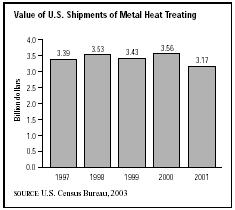SIC 3398
METAL HEAT TREATING
This category covers establishments primarily engaged in heat treating of metal for the trade.
NAICS Code(s)
332811 (Metal Heat Treating)
The various forms of heat treating are used to make metals more durable and to improve their mechanical performance for manufacturing. Heat treating processes include brazing, annealing, hardening and tempering, normalizing, nitriding, and carburizing. In each of these processes, controlled heat is generated from an electrical or gas-based source and applied to metals, making heat treatment an energy-intensive industry. Heat treated metals are required in components produced for aerospace, industrial machinery, heavy equipment for construction and agriculture, motor vehicles, and general manufacturing.
According to the U.S. Census Bureau, roughly 800 establishments operate in this category. Industry employment in 2000 totaled 24,752 workers receiving a payroll of almost $890 million. Of these employees, 18,933 worked in production, putting in almost 38 million hours to earn wages of more than $587 million. Overall shipments for the industry were valued at almost $3.2 billion in 2001.

In 1998, Cleveland-based industry leader LTV Corp., which generated sales of almost $4.3 billion, joined together with Steel Dynamics Inc. (Butler, Indiana) and Weirton Steel Corp. (Weirton, West Virginia) to create a World Wide Web-based dynamic portal trading system called MetalExchange, through which to sell steel. Weirton's existing online sales site generated about $50 million per year during the previous two years. Then, in late 1999, General Motors announced it would conduct all $87 billion worth of its steel purchasing online within two years. Online commerce promised increased efficiencies, reducing purchase order processing from $100 to $10 by 2001. GM chose to conduct its business through MetalSite, an outgrowth of MetalExchange, with added equity partners Bethlehem Steel Corp. of Bethlehem, Pennsylvania, and Chicago-based Ryerson Tull Inc. GM's proposed processing fee of 1 to 2 percent fell to between 0.25 and 0.5 percent before even getting online, with steel industry hopes that it would disappear altogether.
However, like many online ventures, MetalSite failed to live up to expectations, and the site was temporarily shutdown in June of 2001, while new owners retooled it. According to a December 2001 issue of American Metal Market , "MetalSite was the leading e-commerce site for steel sales when it began operations. It was among the first to shut down when the dot-com fortunes fell flat. Now, it is one of the first to return to the market, albeit with a different owner and a leaner, meaner approach to doing business in the steel industry."
Other industry leaders included Curtiss-Wright Corp. of Lyndhurst, New Jersey, with $746 million in 2003 sales; Southington Savings Bank of Plantsville, Connecticut; Wheeling-Nisshin Inc. of Follansbee, West Virginia; and Bodine Aluminum Inc. of St. Louis, Missouri.
An estimated 650 U.S. establishments performed metal heat treating in the early 2000s. The total number of establishments declined slightly between the 1980s and 1990s. Industry shipments of heat-treated metals totaled $3.19 billion in 1995, which was roughly a 23 percent pre-inflation increase over the previous year. In the 1990s the value of this industry's output grew by more than 50 percent before inflation. After peaking at $3.56 billion in 2000, however, the value of industry shipments declined to $3.17 billion in 2001.
Of the 24,752 workers in the industry in 2000, some 18,933 were engaged in production labor and earned an average of $15.46 per hour—about 3 percent higher than average for manufacturing employees in the United States.
Early in the twenty-first century, the employment levels of many occupations in the primary metal products industry, which includes heat treatment facilities, were expected to decrease. Those occupations that expected to face reductions of more than 25 percent included miscellaneous hand workers, electricians, metal pourers, metal/plastic machine workers, furnace operators, and welders. Those occupations that expected to face reductions between 10 and 25 percent included production worker supervisors, general laborers, heat treating machine operators, furnace operators, truck and tractor operators, crushing and mixing machine operators, inspectors, crane operators, material movers, machine tool workers, secretaries, machine feeders, science and mathematics technicians, material moving equipment operators, and metal molding machine operators. Sales workers were expected to be in demand, however, in the early 2000s.
Further Reading
Infotrac Company Profiles. 1 January 2000. Available from http://web2.infotrac.galegroup.com .
Robertson, Scott. "New Owner Relaunched Leaner, Meaner MetalSite, ScrapSite." American Metal Market, 10 December 2001.
U.S. Census Bureau. "Statistics for Industry Groups and Industries: 2000." February 2002. Available from http://www.census.gov/prod/2002pubs/m00as-1.pdf .
——. "Value of Shipments for Product Classes: 2001 and Earlier Years." December 2002. Available from http://www.census.gov/prod/2003pubs/m01as-2.pdf .
Comment about this article, ask questions, or add new information about this topic: